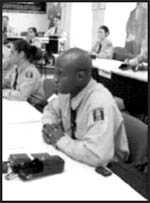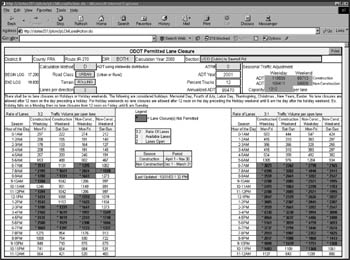Fact Sheet 13 – Work Zone Training: Examples of What Agencies Are Doing
Summer 2007
Each year work zone practices and procedures change as practitioners look to new strategies to combat congestion and alleviate potential safety issues caused by construction and maintenance activities. Local, State, and Federal agencies develop and implement training programs for roadway workers, project engineers, law enforcement officers, and others to provide practitioners with the knowledge needed to implement strategies that can improve conditions for roadway workers and travelers. Training is identified by the Federal Highway Administration (FHWA) as a priority in the Work Zone Safety and Mobility Rule where it states: "States shall require that personnel involved in the development, design, implementation, operation, inspection, and enforcement of work zone related transportation management and traffic control be trained appropriate to the job decisions each individual is required to make."[1]

Law Enforcement Officers in
Training
Law Enforcement Training for Work Zones – Louisiana and FHWA
The responsibilities of police officers stationed in work zones may include enhancing motorist awareness through the visible presence of officers, performing active enforcement, providing incident management services, and sometimes providing an extra layer of review of proper traffic control. Safety concerns arise when police officers perform traffic duties (whether or not in a work zone), as more police officers are killed by traffic-related accidents than by other job-related hazards.[2] To help address this issue in Louisiana, a Louisiana Work Zone Task Force was formed in 2001 and created 45 recommendations in eight work zone categories, with one of the categories concentrating on work zone training. The Task Force has worked systematically to make improvements to Louisiana work zones over the past several years. In response to the recommendations, the Louisiana Department of Transportation and Development (LADOTD) established a policy for law enforcement training. This policy requires all police officers working on project sites to be certified in work zone traffic control, including proper placement of police officers and patrol vehicles. Prior to starting work, police officers must provide a certificate of course completion to the hiring contractor. LADOTD and the FHWA Louisiana Division began providing training for police officers to teach three main roles for an officer in a work zone: presence, enforcement, and traffic control. One issue that is discussed in the training is for law enforcement to stay upstream of the back of the queue in order to alert motorists to stopped traffic ahead. The course also identifies the roles and responsibilities of the LADOTD project engineer and the contractor, and outlines the relationship these individuals have with law enforcement representatives.
In response to the national-level work zone safety issue, FHWA organized a national group to develop a work zone law enforcement training course, in which FHWA solicited input from state level law enforcement training programs such as Louisiana, New Jersey, and Oregon. The FHWA course, entitled the Safe and Effective Use of Law Enforcement Personnel in Work Zones, was developed in close coordination with the National Transportation Safety Board (NTSB), the National Highway Traffic Safety Administration (NHTSA), the International Association of Chiefs of Police (IACP), and the National Sheriff's Association (NSA), along with other stakeholders including State and local law enforcement, engineers, and contractors. The training materials provide officers with useful, easy to understand information to help them safely operate within work zones. The course covers the duties and responsibilities of all parties involved with work zones and covers topics including coordination and communication, understanding basic traffic control, and law enforcement stationing and positioning practices. FHWA developed the course as a template that could be used by State and local trainers and others and easily adapted to the specific needs of jurisdictions. Course materials are available for download at https://ops.fhwa.dot.gov/wz/outreach/outreach.htm.
Ohio Training Practices

ODOT Permitted Lane Closure Analysis Tool
In an effort to minimize the impacts on the traveling public resulting from work zones, the Ohio Department of Transportation (ODOT) Office of Traffic Engineering (OTE) implemented the policy, entitled Traffic Management In Work Zones—Interstate and Other Freeways, on July 18, 2000. One of the issues this policy addressed was training. The policy states, "The Office of Traffic Engineering will provide training in the development of the Permitted Lane Closure Maps, the use of queue modeling software, and work zone traffic control and inspection upon request."[3]
ODOT's policy applies to any workers in the State of Ohio and requires public sector personnel, consultants, and contractors to receive training. To implement its policy, ODOT developed three training venues for personnel involved in the development, design, and implementation of work zones: HT Academy for ODOT personnel, Traffic Academy for consultants, and Worksite Traffic Supervisor for contractors. For ODOT personnel, ODOT took on the largest internal training initiative in its history for people involved in construction and highway management. HT Academy consists of dozens of classes to comprehensively train and certify approximately 2,500 ODOT highway workers, project inspectors, and other public sector personnel. The training requires ODOT personnel to take and pass certification exams in two maintenance of traffic (MOT) classes, a beginner and an advanced class. An example of a tool that ODOT provides training on is the Permitted Lane Closure Analysis Tool. For contractors, bigger jobs have a plan note for a dedicated work site supervisor, in which that person must be certified in MOT through one of a couple ODOT-approved classes. For design consultants, ODOT requires all consultants who request prequalification for complex roadway projects to attend and pass a certification test for work zone design.
Iowa Training Programs
The Iowa Department of Transportation (DOT), along with the Associated General Contractors (AGC) of Iowa and the FHWA Iowa Division, is addressing growing concerns for worker safety. The three organizations formed an AGC/DOT Safety Task Force to focus on worker safety training. The task force agreed that a series of training videos could address this need by detailing the dangers of a work zone and the safety considerations critical for all workers, including law enforcement, flaggers, surveyors, utility workers, and traffic control technicians. The series consists of 12 videos along with instructional guidelines to accompany each video. Each stand-alone video consists of 10 to 13 minutes of documentary detailing the dangers and safety considerations of specific types of highway work. The series is highlighted by the first video titled, "One Step from Death" which provides general awareness of the potential dangers of work zones and the importance of every worker in ensuring safety.
Points of Contact:
Dave Holstein
Ohio Department of Transportation
Administrator, Office of Traffic Engineering
614-644-8137
Email: David.Holstein@dot.state.oh.us
Mary Stringfellow
FHWA Louisiana Division
Technology Management
Systems Engineer
225-757-7610
Email: Mary.Stringfellow@fhwa.dot.gov
Tracy Scriba
Federal Highway Administration
Work Zone Mobility & Safety Team
202-366-0855
Email: Tracy.Scriba@dot.gov
![]()
U.S. Department of Transportation
Federal Highway Administration
Publication No. FHWA-HOP-07-119
- 23 CFR 630 Subpart J: Work Zone Safety and Mobility Rule (https://ops.fhwa.dot.gov/wz/resources/final_rule.htm)
- National Law Enforcement Officers Memorial Fund (http://www.nleomf.com/TheMemorial/Facts/causes.htm)
- Policy Statement from ODOT website: http://www.dot.state.oh.us/policy/516-003p.pdf
To view PDF files, you need the Adobe Reader.
